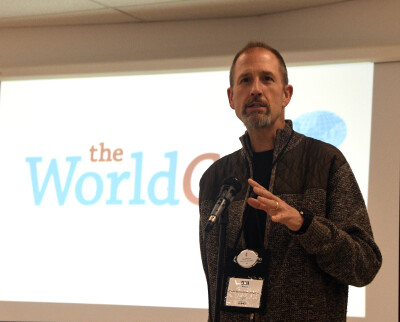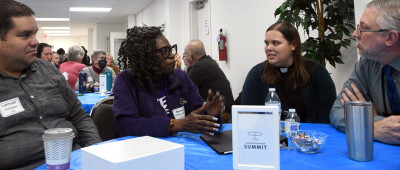Cooperative Parish Summit ignites new spirit of ministry
By Melissa Lauber In January, more than 150 people gathered for a day of inspiration and ignition. “We want to set the world on fire,” said the Rev. Wanda Duckett, superintendent of the Baltimore Metropolitan District.
In January, more than 150 people gathered for a day of inspiration and ignition. “We want to set the world on fire,” said the Rev. Wanda Duckett, superintendent of the Baltimore Metropolitan District.
Their spark of choice? The cooperative parish.
Cooperative parishes bring churches together in shared mission and ministry. Within the many configurations these can take, “the Spirit moves and combusts,” said the Rev. Ann Laprade, superintendent of the Baltimore Suburban District.
The Baltimore Region has been a leader in the creation of cooperative parishes in the BWC, using them to bring together churches to share staff, resources, ministry, worship, and outreach in creative ways. “Across the region, these churches are actually experiencing the connectional system and the heart of Wesleyan theology,” Laprade said. “They’re using resources to become something larger than themselves.”
The summit featured a unique style of information sharing – A World Café model, in which cooperative parish parishioners shared five minutes talking about their experiences, then participants in small groups talked about the presentations for 18 minutes, and then came back together to share a nugget of wisdom with the whole group.
This model of sharing awakened curiosity and a spirit of exploration, Duckett said.
The four groups sharing in the World Café were:
- The Cooperative Parish of Northern Baltimore County, with six churches in which pastors model shared ministry;
- The Northern Carroll Cooperative Parish, in which eight churches come together with an emphasis on mission;
- Resurrection West, a partnership between Ames and Metropolitan UMCs, where the two churches, with very different cultures, share worship space at Metropolitan, and work to address poverty in their communities, often partnering with more affluent suburban congregations; and
- Mission Central Parish, with 11 churches, which uses an anchor-style of ministry, with one large church (Fallston UMC) providing administrative oversight and resourcing, and lay people and retired clergy leading worship and focusing on mission and outreach.
“Better together” was the refrain that echoed throughout the room during the day-long Cooperative Parish Summit.
 One of the benefits of this style of connectional ministry is that it cuts down on meetings, said the Rev. Scott Shumaker and Laurel McNeal of the Cooperative Parish of North Baltimore. While the two pastors share information and make decisions together in a weekly team meeting, the six churches hold only 34 meetings each year.
One of the benefits of this style of connectional ministry is that it cuts down on meetings, said the Rev. Scott Shumaker and Laurel McNeal of the Cooperative Parish of North Baltimore. While the two pastors share information and make decisions together in a weekly team meeting, the six churches hold only 34 meetings each year.
Worship is the same at each church, with Shumaker and McNeal, each leading three services on Sunday morning.
At the North Carroll Cooperative Parish, the pastors divide the ministry differently. The Rev Melissa Rudolph oversees administrative issues and worship; the Rev. Jerry Gautcher handles pastoral care and outreach and oversees and parish caring team, with one representative from each of the parish’s eight locations; and the Rev John Rudolph does youth and children’s ministries, including five weeks of summer camp focused on sports, STEM, art, field and stream and agri-science.
At the Mission Central Cooperative Parish, the anchor model, “an outward mindset is the place we start from. Every church partners with a community group and do some mission and ministry together as a parish,” said the Revs. Karin Walker and Danny Breidenbaugh, the parish’s two ordained leaders
Even the smallest church on the Mission Central parish, which has eight members, runs a food pantry. Once, when they were running short of food, the members put out a call to the other churches and ended up with enough food to last through the year.
Walker said some churches thinking about participating in a cooperative parish fear losing their identity. However, she said, this is not the case. She compared the parish to the lighting of a unity candle at a wedding. Two candles come together to light a third – but the two people lighting the candle do not lose their identities.
At Mission Central, one participant at the summit said, it seems like 12 churches brought their light together and created a 13th thing. “It’s excited to see what God is doing.”
For some churches at the summit, cooperative parishes seem like one solution to address the “cold reality of survival.”
But there’s nothing to say that churches need to be struggling to come together in ministry with others, Laprade stressed.
What defines a cooperative parish “is that desire to reach for new life,” she said. “They’re reaching out to be a sign of God and the light of Christ. They’re reaching out for ways to bring lights together that shine more brightly to those who have yet to hear the story. … Something new is being born here.”
One of the BWC’s newest cooperative parishes is in Hancock, Md. The Rev. John Wunderlich, superintendent of the Cumberland-Hagerstown District, is excited about the Spirit-led opportunities that seem to be arising there and in other shared ministries. But he’s not surprised.
“People are created to be in community, to be in connection with one another. We’re starved for it,” he said. “When we’re offered opportunities to be involved in something like this, we’re drawn to it. It reignites you.”
Wunderlich also cautions against being judgmental of small churches. Our small churches, in small communities – well, no one is better positioned to be the light of the Gospel in that community than that church. They have a footprint there; they have relationships in the community. They can meet needs with and for Jesus. … No one can reach their community or be the light of Christ in the neighborhood, like they can.”
The conversation around the tables was enthusiastic as participants at the summit shared insights and questions. Among their comments:
- Some churches feel like they’re losing their power if they get together. But it’s not about power, it’s about the love of God.
- Sometimes moving forward means surrendering the past.
- To do effective ministry we need to join others to have critical mass. When we connect, we can have better Bible study, confirmation classes, choirs, Vacation Bible Schools, mission trips, Scouting, and so much more. (“Easter egg hunts are more fun with more than one kid.")
- Parishes don’t have to just be geographical neighbors; they can be formed around shared interests or a common mission field. It’s important to choose the right church to partner with.
- Communication and collaboration are key.
- Laity must be involved in meaningful ways.
- We need to embrace a new “we.”
Before the day was over, several of the participants began making plans for how they might explore becoming a cooperative parish, and they were encouraged to make a start – even if it meant just sharing an activity with a nearby church.
During the sharing, one of the participants noted that when she first entered the summit, she cynically noted that she had received a book in her gift bag. But then she noticed the book was blank. “It’s empty” – she exclaimed. But after time passed, she embraced her empty journal. “This book, this day, gives you so much space for creativity,” she said.
The only thing that is holding us back, said the Rev. Bill Brown who moderated the summit, “is a lack of spiritual imagination.” But after the summit, the wheels of creativity and imagination had begun to spin. The sparks began to fly.
